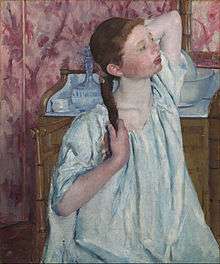American Art Association

The American Art Association was an art gallery and auction house with sales galleries, established in 1883.[1]
It was first located at 6 East 23rd Street (South Madison Square) in Manhattan, New York City and moved to Madison Ave and 56th St. in 1922. It was the first auction house in the U.S. and had a strong presence in New York during the period of American history known as the Gilded Age, hosting some of the cities major art exhibitions at the time.[2] The galleries and auctions were devoted to paintings by American artists and also had an Oriental Art Department. The aim of the association was to promote American art through a highly visible, cosmopolitan auction venue.[3]
History
The American Art Association (AAA) was founded by James F. Sutton (President of AAA), R. Austin Robertson, and Thomas Kirby (auctioneer) (1846–1924) in 1883. [4] Thomas Kirby had grown up in Philadelphia and moved his family to New York in 1876, in the years prior to starting the AAA, he worked at various auction firms and importers in New York.[5] In 1882, Sutton proposed a partnership that would result in the formation of the American Art Association.[6]
During AAA's operation, Sutton, Kirby, Robertson and their staff supervised the sales of hundreds of collections and works of art. R. Austin Robertson traveled to China and Japan to make selections for the Oriental Department.[7] In its first year, AAA exhibited Thomas B. Clarke's collection of American paintings that was a benefit for the National Academy of Design.[8] The AAA held its first auction in 1885.[9]
In 1929 it merged with the Anderson Auction Company to form the American Art Association-Anderson Galleries, Inc, and in 1938, the firm was taken over by Parke-Bernet Galleries, Inc., which had been formed a year earlier.
In 1964, Sotheby's purchased Parke-Bernet, then the largest auctioneer of fine art in the United States.[10]
The Archives of American Art, Smithsonian Institution maintains the bulk of the American Art Association records. Additional records are found at the Frick Art Reference Library maintains much of the American Art Association records.
Publications
- American Art Association. 1910. A plan and interesting information concerning the American Art Association and the American Art Galleries, New York. New York City: American Art Association. OCLC:81170983
References
- ↑ "American Art Association Records". Archives of American Art.
- ↑ "Art market". Britannia. Retrieved 2013-10-28.
- ↑ Bolas, Gerald D. The Early Years of the American Art Association. 1998. Masters thesis published by University of Michigan. vi.
- ↑ "American Art Association Records". Frick.org.
- ↑ "Illustrated Catalogue of Master Works". Archive.org. Retrieved 2013-10-28.
- ↑ Kirby, Thomas E. "Autobiography." American Art Association Papers. Archives of American Art, Smithsonian Institution, Washington D.C.
- ↑ http://www.frick.org/sites/default/files/FindingAids/AmericanArtAssociation.html MS 15, Series I, Box 6. 6/6
- ↑ Bolas, Gerald D. The Early Years of the American Art Association. 1998. Masters thesis published by University of Michigan.
- ↑ http://www.aaa.si.edu/collections/american-art-association-records-6973
- ↑ http://www.forbes.com/2001/11/14/1114timeline.html
External links
- 1877-1924. The Frick Collection/Frick Art Reference Library Archives, American Art Association Records.
- 1853-1924. Archives of American Art, Smithsonian Institution American Art Association Records.
- Hundreds of digitized American Art Association auction catalogs available from the Metropolitan Museum of Art Libraries
- Documenting the Gilded Age: New York City Exhibitions at the Turn of the 20th Century (NYARC)
- Digitized Version of "Annual exhibition of the Society of Landscape Painters" catalogue at the American Association art galleries.
- Catalog records for American Art Association related, digitized sales catalogs
- "Gilding the Gilded Age: Interior Decoration Tastes & Trends in New York City" website
- American Art Association Catalogs in Worldcat